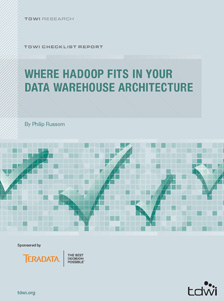
TDWI Checklist Report | Where Hadoop Fits in Your Data Warehouse Architecture
July 22, 2013
Business intelligence (BI) and data warehousing (DW) professionals
are aware of Hadoop’s general benefits for BI and DW. They even
know that Hadoop’s most credible use cases focus on analytics and
managing multi-structured and no-schema data. This is good news
for the integration of Hadoop into mainstream BI and DW practices.
However, the Hadoop ecosystem of products is still quite new, so
most BI and DW professionals haven’t yet determined where to
begin their integration of Hadoop with established platforms for BI,
DW, data integration (DI), and analytics.
The first step toward successful integration is to determine where
Hadoop fits in your data warehouse architecture. Hadoop is a
family of products, each with multiple capabilities, so there are
multiple areas in data warehouse architectures where Hadoop
products can contribute. At the moment, Hadoop seems most
compelling as a data platform for capturing and storing big data
within an extended DW environment, plus processing that data for
analytic purposes on other platforms.
This TDWI Checklist Report discusses adjustments to DW
architectures that real-world organizations are making today, so
that Hadoop can help the DW environment satisfy new business
requirements for big data management and big data analytics.